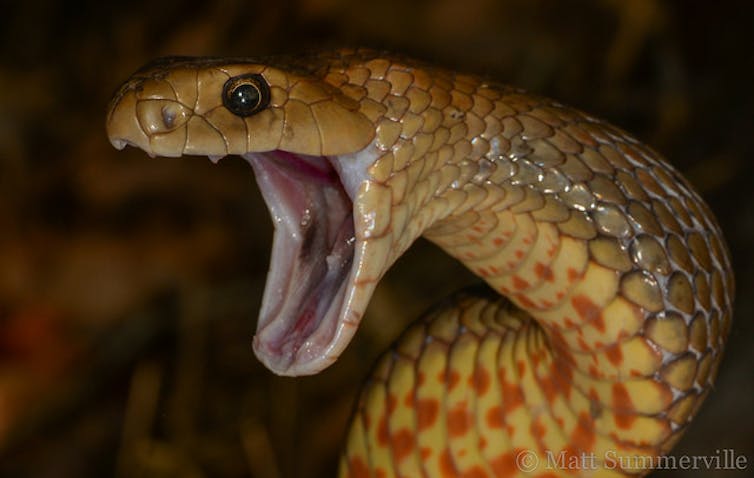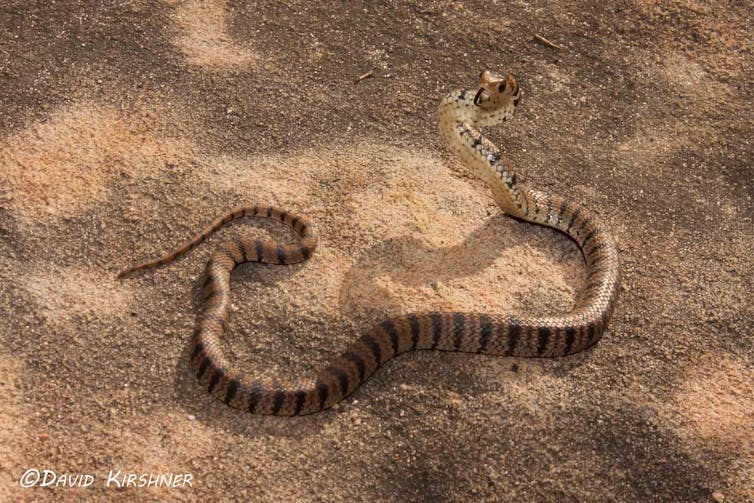Like alchemists with killer precision, brown snakes make different venoms across their lifetime
- Written by Timothy N. W. Jackson, Postdoctoral Research Fellow, Australian Venom Research Unit, University of Melbourne
It’s spring in Australia and that means reptiles are starting to move about again. Including snakes.
The venom of the eastern brown snake (Pseudonaja textilis) is, drop for drop, one of the most potent of any venoms tested on laboratory mice.
Venoms work by targeting the bitten animal with deadly chemicals. And our recent research shows toxins in the venom of eastern brown snakes change as the snakes grow from juveniles to adults. It’s the first example of a significant age-related change in venom from an Australian snake.
It’s a beautiful example of evolutionary adaption, in which the chemistry of the snake’s venom appears to change in parallel with its diet.
Read more: Why I love surrounding myself with venomous critters
What is snake venom?
Venoms are typically a mixture of different toxins, each of which attacks the system of a potential prey animal or predator in a different way.
Sometimes toxins work together, each making the other more powerful, and sometimes they work completely independently, engaging in chemical warfare on multiple fronts.
Brown snake venom contains many toxins, but there is one toxin above all others that is responsible for the life-threatening effects of bites to humans. This toxin is a “haemotoxin”, which means it attacks the blood.
 Eastern brown snakes have very small fangs and only deliver small quantities of venom when they bite. The venom is amongst the most potent of any snake in the world, however, and even a small scratch from a fang can result in a potentially fatal envenoming.
Matt Summerville, Author provided (No reuse)
Eastern brown snakes have very small fangs and only deliver small quantities of venom when they bite. The venom is amongst the most potent of any snake in the world, however, and even a small scratch from a fang can result in a potentially fatal envenoming.
Matt Summerville, Author provided (No reuse)
The haemotoxin starts clotting the blood at an extremely elevated rate, using up all of the coagulation factors, which clot the blood under normal circumstances. When all these are used up, the victim is at risk of bleeding to death.
In the worst case scenario this toxin, perhaps working with others, gives the system such a shock that people collapse within a short period of time following the bite. In this situation, immediate CPR can be the difference between life and death.
Why venom evolved
Venom is a tool that has evolved in snakes to help them secure a meal: it gives them a chance of overpowering animals that would otherwise be very difficult for them to subdue. Venom and its toxins are therefore “designed” (by evolution) to mess up the normal operations of a prey animal’s body.
Read more: Curious Kids: how do snakes make an sssssss sound?
The best toxins for this purpose may differ according to the specific type of prey animal (e.g. mammal or reptile), or the condition of that prey animal (e.g. whether it is active or inactive) when the snake finds it. As a result, we often find snakes that feed upon different types of animals have different toxins in their venoms.
This starts to get really interesting when you consider brown snakes, because adult brown snakes seem to have quite different diets from baby brown snakes.
Testing a venom hypothesis
Age-related shifts in venom chemistry have already been demonstrated for the venoms of a few species of pit vipers from the Americas, but not for anything even remotely related to Australian brown snakes.
This wasn’t because people hadn’t looked – several species of Australian snake had been investigated, but no evidence of a significant age-related change in venom had been found for any of them. This made sense to me, because none of those snakes dramatically change their diets throughout their lives.
Brown snakes are special – as far as we know the juveniles eat lizards almost exclusively, whereas the adults are generalists that eat a lot of mammals.
 Juvenile eastern brown snakes are often banded. As the snakes increase in size the bands typically fade, although they are retained in some adult snakes.
David Kirshner, Author provided (No reuse)
Juvenile eastern brown snakes are often banded. As the snakes increase in size the bands typically fade, although they are retained in some adult snakes.
David Kirshner, Author provided (No reuse)
Baby snake venom is different
When we compared venom in adult and baby brown snakes, we did indeed find them to be different. Baby brown snake venom seems to entirely lack haemotoxins: instead, it’s almost exclusively composed of neurotoxins – toxins that attack nerve junctions.
What this suggests is that the haemotoxins that are so dangerous to humans (and lab mice) aren’t very effective against the lizards that baby brown snakes eat. We can make this dietary link with a degree of confidence because many other Australian snakes that feed exclusively on lizards have similar venom – no haemotoxins, only neurotoxins.
Read more: Snakebites are rarer than you think, but if you collapse CPR can save your life
We don’t yet know what this means from a clinical perspective. It may be that baby brown snake venom is less dangerous to humans than adult brown snake venom, but the opposite might also be true – brown snake antivenom might be less effective against the venom of the babies.
There has been at least one fatal bite from a very small brown snake in Australia, so they must be treated with respect at any age.
As always, the best policy for snakes is to leave them alone and let them go about their business, and to teach children to do the same – snakes want no more to do with us than we want with them.
Authors: Timothy N. W. Jackson, Postdoctoral Research Fellow, Australian Venom Research Unit, University of Melbourne



